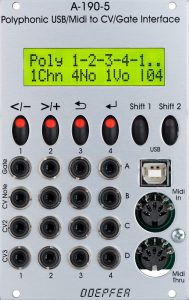The A-190-5 is a Midi-to-CV/Gate interface primarily intended for polyphonic applications. This means that up to four modular synthesizer voices can be controlled via any midi keyboard.
Polyphony is still a rather exotic “fringe phenomenon” in the modular area. Effort, cost and complexity to control such a system appear relatively high compared to modern analog or virtual-analog polysynths. Nevertheless, there is a lot going on here that I personally think is extremely exciting.
The interface has Midi-In and Midi-Thru, can also be addressed via USB and allows the control of up to four analog synthesizer voices with gate, CV for pitch and velocity, as well as configurable CV outputs for modulation signals.
UPDATE: A new firmware is available!
I will add sound examples to the new features in a further update.
From day one, the A-190-5 interface was a great tool. Polyphony was possible and easy to use, but also unison, quadruple monophonic, all with up to 10 V control voltage (for VCOs that’s 10 octaves!) and a user interface that was easy to understand.
Of course, in the summer of 2021 I still had one or two wishes about what else could perhaps be installed. That’s how it is with digital modules. And even if it’s “just” software: Every wish means a lot of work, it has to be planned, programmed, tested, tested in practice by beta testers, feedback processed, errors looked for, reconsidered and programmed and tested again and so on until the result is really “established”. And yes: I think the result is impressive.
Now the new firmware is here. Download here: https://www2.doepfer.eu/en/faqs/item/update-a-190-5
What’s new?
- The thing with the USB port. If you connected the module to the DAW via the USB port and left all ports “open” in the DAW, midi feedback loops often occurred. The module outputs all notes that come in via DIN-Midi or USB-Midi directly via USB-Midi. The problem is now resolved.
- The stability of the USB connection has been improved. (I never had any problems with it myself, but there were apparently stability issues for some Mac users.)
- Portamento: Yes, the module has been given a portamento function! This is extremely useful. Is this a competitor to the A-171-4 polyphonic slew limiter? Actually not at all, since the A-171-4 works with photo resistors, which, due to their principle, always work somewhat “imprecisely” and “organically”, while the portamento in the A-190-5 works very precisely and “mathematically”. Choose your player!
- Pitch Bend: In the MIDI world, pitch bend is not a normal “controller”, but a “message” that requires two bytes (14 bits). This was not covered in the first version, but now the pitch bend control is automatically added to the control voltage for the pitch. In the menu we can set this to plus/minus 1 to 60 semitones.
- Round Robin: The ideal assignment of the pressed keys to the “voices” (or VCOs) is a bit of a question of faith. In an “overflow model” the first synthesizer voice is always addressed as long as we play monophonically. Only when we press a second, third or fourth key at the same time, the second, third or fourth synthesizer voice will be addressed. This ensures very natural portamento, and tonal differences between the analog synthesizer voices only play a minor role. This was the operating mode in the module’s original firmware. Now, you may be a fan (like me) of the subtle – or not so subtle – changes in timbre with each note played. I also like to connect four A-111-6s with slightly different settings to the interface. Something like this was possible in the Korg MonoPoly. There is now – in addition to the previous mode (now called “Poly 1”) a new mode “Poly 2”, which rotates a monophonic voice through the four synthesizer voices with each new note in “Round Robin” mode and only then switches back to the “overflow model”. I think it’s very successful, the results always sound pretty organic and “musical”.
User interface
Inputs:
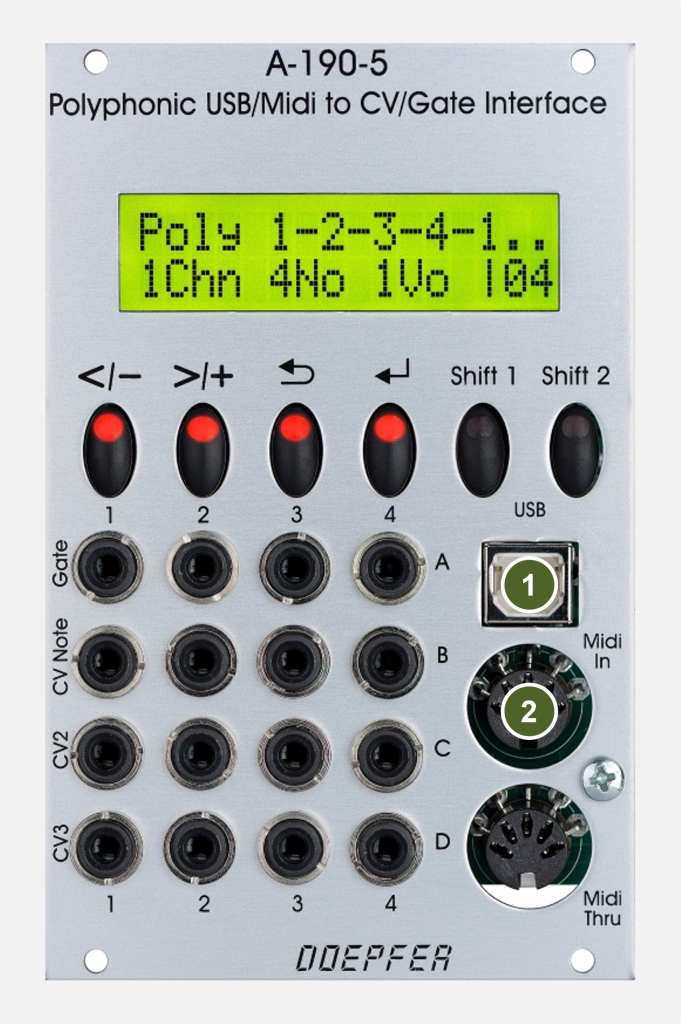
- USB: USB interface (input and Midi-Thru) for Midi data from a sequencer or master keyboard.
- Midi In: 5-pin standard midi input
Outputs:
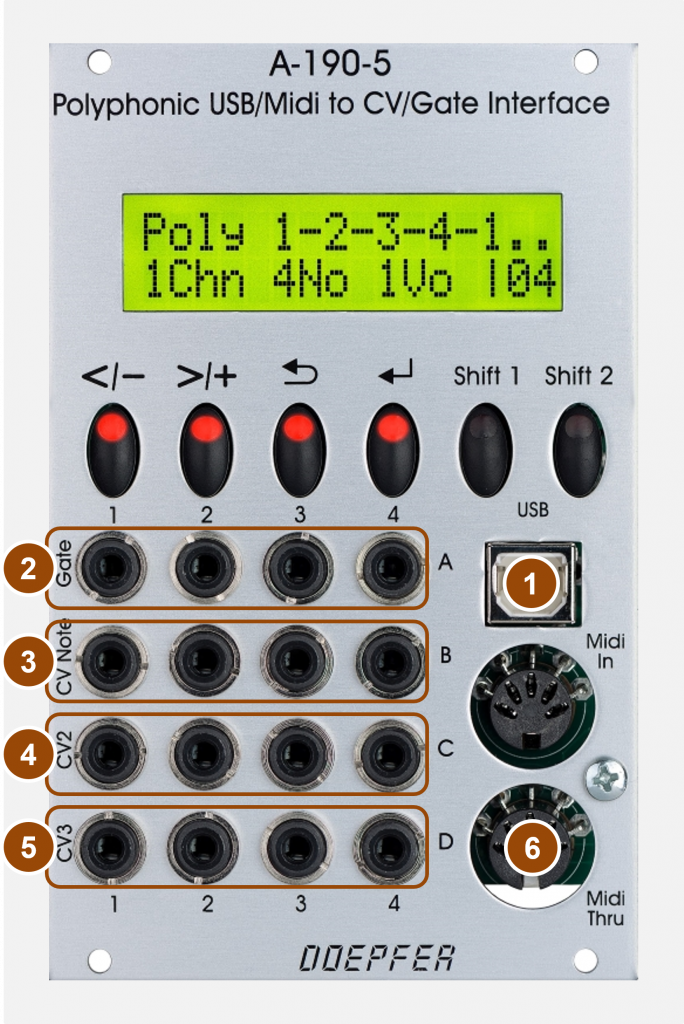
- USB: In addition to a MIDI input via USB, this socket also has a MIDI thru looped through from the USB or MIDI input.
- Gate 1-4: Gate outputs for the four analog voices.
- CV Note 1-4: Four control voltage outputs for the frequency of the oscillators.
- CV2 1-4: Control voltage outputs for velocity.
- CV3 1-4: Programmable control voltage outputs generated from up to four different MIDI controllers.
- Midi-Thru: Midi output that loops through the Midi input signal from “Midi In” or the USB input.
Controls:
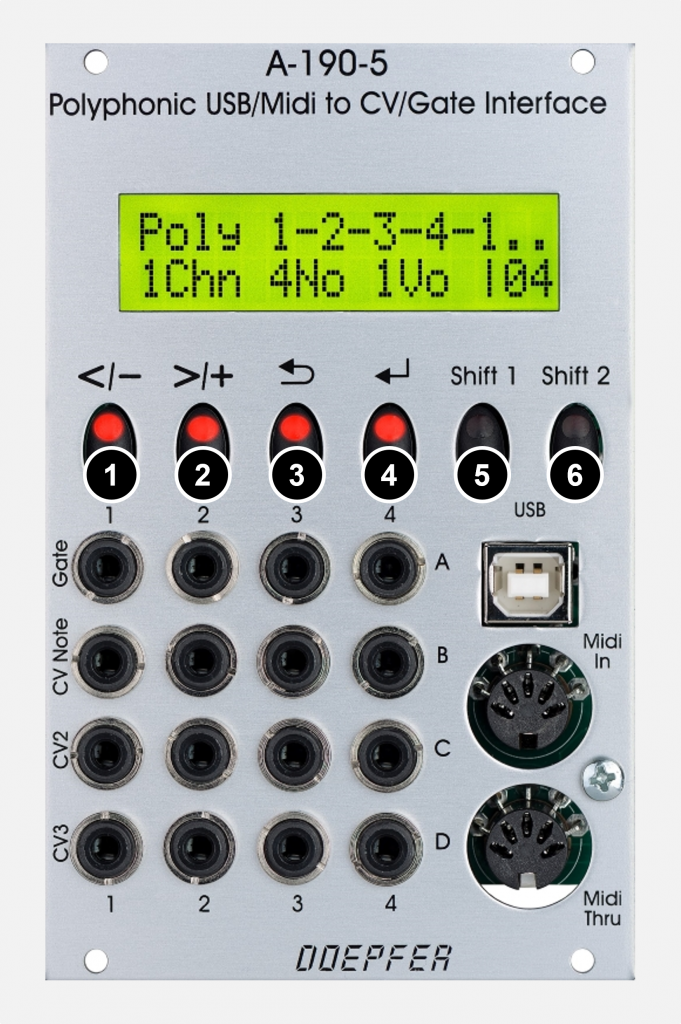
- </-: Button to navigate one position to the left in the menu.
- >/+:Button to navigate one position to the right in the menu.
- [Zurück]:Button to cancel a process in the menu or to navigate up a level.
- [Enter]:Button to confirm a process in the menu or to navigate down a level.
- Shift 1: Currently not used.
- Shift 2: Currently not used.
Connection possibilities via the board
In contrast to many other more recent Doepfer modules, there are no configuration options on the boards. But there are two pin strips for the output gate signals and “CV Note” – control voltages. Small cables fit on it (look for “jumper cables” at electronics stores) via which you can connect the interface to the polyphonic VCO A-111-4 or the polyphonic ADSR A-141-4 (from version 2, with the first version you still have to solder).
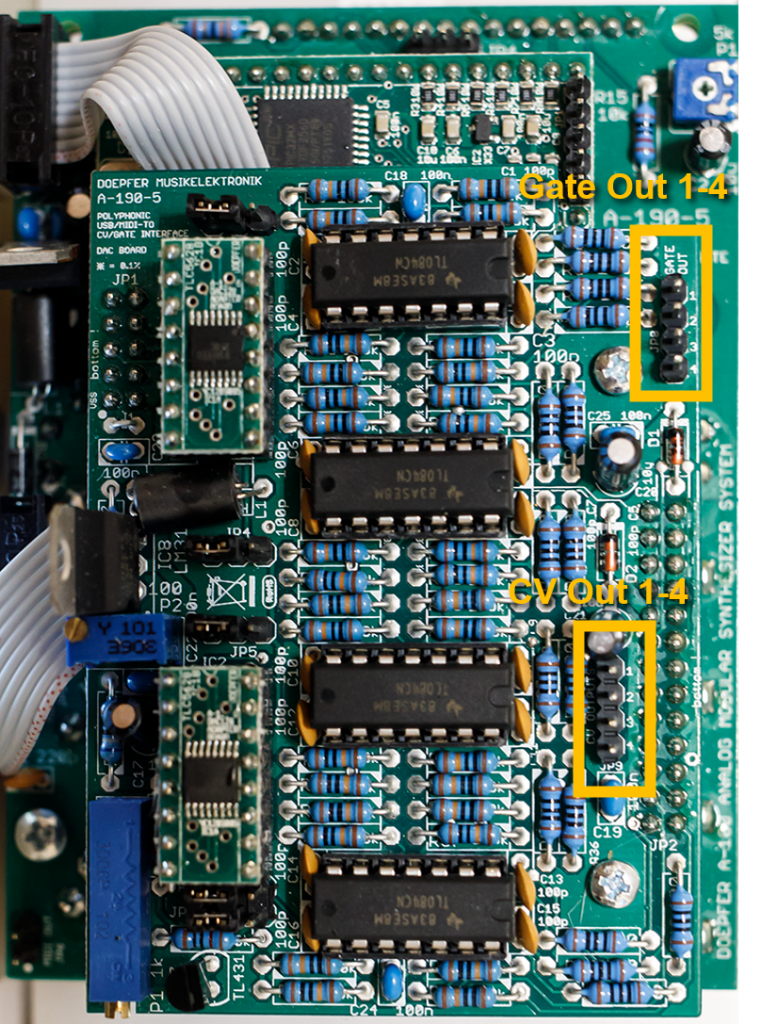
Operating modes at a glance
The “+” and “-” buttons can be used to switch between the six operating modes of the interface. The differences lie in the number of midi channels to which the module reacts and in how many simultaneous notes per midi channel are converted into the modular world of CV and gates.
| Operating mode: | Midi channels: | Notes per channel: | Behavior of the analog outputs: |
|---|---|---|---|
| Unisono 1+2+3+4 | 1 | 1 | Monophonic on all four outputs simultaneously, all outputs play (unison) the same notes. All in all, a single modular voice (issued four times). |
| Mono/Uni 1+2;3+4 | 2 | 1 | Outputs 1+2 play (unison) the notes of the first midi channel, outputs 3+4 (unison) the notes of the second midi channel. In total two modular voices (each issued twice). |
| Mono 1;2;3;4 | 4 | 1 | Quadruple monophonic, each monophonic output plays the notes of the corresponding midi channel set in the interface. In total four modular voices. |
| Poly 1-2-3-4-1.. | 1 | 4 | Four-part polyphony, overlapping notes are assigned to the next (free) output. In total four modular voices. |
| Poly 1+2-3+4-1.. | 1 | 2 | Two-part polyphony, the notes played are assigned to outputs 1+2 (unison) and 3+4 (unison) in rotation. In total two modular voices (each issued twice). |
| Poly 1-2-1;3-4-3 | 2 | 2 | Two-voice polyphony with two midi channels, outputs 1 and 2 are assigned the notes of the first midi channel in rotation, outputs 3 and 4 are assigned the notes of the second midi channel in rotation. A total of four modular voices. |
Programming the options
If you press the “Enter” key in one of the six operating modes, you get to the edit menu of the interface. You can switch between the options with the “+” and “-” buttons, the values for the individual options are set by pressing “Enter” and then the “+” / “-” buttons.
| Option: | Settings: |
|---|---|
| Retrigger | Time from 0 to 50 milliseconds. At 0 ms, no new trigger/gate is output on the corresponding analog output when playing legato. |
| Midichannel | The Midi channel whose notes the module converts into analog gates and control voltages (channel 1 to 16). In the operating modes for several Midi channels, the channels are set one after the other and each completed with “Enter”, then the next channel selection follows. |
| Refnote | The midi reference note for which the interface outputs 0 V as control voltage at output CV1. This is the lowest midi note the module responds to. In the operating modes for several midi channels, the reference notes for each midi channel are set one after the other and completed with “Enter”, then the reference note for the next midi channel follows. The value range of this lowest midi note is midi note #24 to #96, which corresponds to C0 to C6. |
| CV3 | The midi controllers that are output on the four “CV3” outputs. Doepfer has thought very cleverly here and made a separate Midi controller possible for each of the four “CV3” outputs: Controllers such as monophonic aftertouch, modulation wheel or sustain pedal are not generated per note, but per Midi channel. Especially in quadruple poly mode, you can use four different controllers for expressive play with the A-100. The controllers are set for each of the four “CV3” outputs one after the other and the programming is completed with “Enter”, then the midi controller follows for the next “CV3” output. |
Retriggering in practice:
What does setting a retrigger time mean in practice? Basically, the interface will output a gate signal at the “Gate” output with every new note. Since gate signals are always output as long as the key is pressed, the generated gate signals of the corresponding analog output overlap when playing legato in “Mono” or “Unisono” modes and the envelope curve is not restarted.
To force a restart of the envelope, you can now set a time from 1-50 ms in which the gate signal is interrupted as soon as the new key is pressed. Here you have to try a little: Too short pauses may not restart the envelope, too long pauses may be heard as a slight delay with percussive envelopes.
If the retrigger time is set to 0 ms, the gate signal is not interrupted when playing legato and the envelope is not restarted in this case. This is actually the standard behavior of classic (monophonic) analog synthesizers.
I could not determine any effects of the retrigger times in the poly operating modes – here the next analog voice takes over with its own gate signal. When the voices “overflow” after the fourth analog voice, the first “CV Note” output again emits a new control voltage, but the first “Gate” output does not interrupt its gate signal to restart it.
Refnote in practice:
For most keyboards, C0 (midi note #24) is sufficient as the lowest possible note, but on an 88-key keyboard like my LMK2, for example, the keyboard extends a little further down to A-1 (that’s the midi note #21). So that the bottom three keys do not remain unused, you can transpose the keyboard up 1 octave if necessary to use the full range. In terms of the interface, there are hardly any upper limits to the pitch range with its control voltage of up to 10 volts (= 10 octaves at 1V/octave!).
Control voltages up to 10 volts:
The A-190-5 interface delivers a potent 10V maximum control voltage. That’s quite a lot for some of the “normal” (non-polyphonic) modules, e.g. an A-140 only delivers up to 8V, LFOs usually up to 5V (or sometimes +/- 2.5V). Of course you can’t break anything with it, but you should turn down the attenuators of filters etc., which are controlled by the A-190-5, a little further in comparison to get meaningful control ranges. By the way, A-141-4 VC ADSR and A-132-8 Octal Poly VCA are inherently designed for +10 V control voltages.
A word (or two) about the polyphonic A-100 modules
Polyphonic modules are a challenge. Where else a simple potentiometer – i.e. a manually adjustable resistor – takes over the regulation of a control voltage, with polyphonic modules this has to be done, e.g. via several integrated VCAs, which are then controlled again via a voltage and said potentiometer. This costs money due to the additional components and it entails effort in the coordination of the module, since the (four) sub-modules should react as similarly as possible.
Doepfer is the only manufacturer I know of to offer a fairly complete range of modules that are suitable for polyphonic use: a quadruple VCO A-111-4, a quadruple filter A-105-4, a quadruple ADSR A-141-4 (which of course basically works voltage-controlled), a quadruple, no, eight-fold VCA A-132-8, a quadruple random module A-149-4, a quadruple slew limiter (portamento) A-171-4 and a polyphonic mixer A-135-5. A lot can be done with this, while the space requirement remains manageable: Filter, ADSR and VCA are each only 8 HP wide “Slim Line” modules. Quadruple LFOs have been around for a long time anyway. And in terms of modularity, of course, we move well beyond the “standard polysynths”, after all you have a modular system.
Maybe a few small auxiliary modules, like a quadruple waveshaper, would be nice.
And yes, one could wish for many more polyphonic filters. In fact, I personally find the filters to be the least problematic modules for polyphonic applications. The Doepfer filters are almost all quite inexpensive and a tuning of several filters is done quickly. Then another free CV input for joint control of the corner frequency and everything is fine. If it should still be a polyphonic filter module, I would personally prefer a slightly slimmed down Xpander filter with as many of the 12 dB and – even better – 6 dB filter modes as possible.
Basic equipment for polyphony
The basis for a polyphonic modular system is actually the midi interface A-190-5. Everything else (A-111-4, A-105-4, A-141-4, A-132-8) is extremely practical and noticeably facilitates operation when playing the system. However, if necessary, this can be replaced by a series of individual modules, which then have to be adjusted to each other “by hand”.
A minimalist polyphonic system could also consist of one A-190-5 and four A-111-6 Miniature Synthesizer Voices. And why not? With the Oberheim Four Voice, you also had to set each voice manually.
-
Comparison of midi interfaces
Module: Type: USB: Range: CV outputs: Clock out: Midi thru: A-190-1 Simple Midi-CV interface with clock / 5 octaves 2 YES YES A-190-2 Narrow Midi-CV interface with multiple CV outputs / 5 octaves 4 / / A-190-3 Similar to A-190-2, but with USB YES 5 octaves 4 / / A-190-4 Similar to A-190-1, but with USB and a wide tonal range YES 10 octaves 2 YES YES A-190-5 Polyphonic Midi-CV interface with a wide tonal range YES 10 octaves 12 / YES A-190-8 Interface specialized in midi clock YES no CV out only clock YES / A-191 Midi-CV interface with many CV outputs, can also be used as a Shepard generator / 5 octaves 16 / / A-192-1 CV-Midi interface with 16 CV inputs / 5 octaves CV inputs only / YES A-192-2 CV/Gate-Midi interface with 6 CV and 2 gate inputs YES 10 octaves CV and gate inputs only / /
Sound examples
-
A-190-5 / Pitchbend
The software update for the polyphonic midi interface A-190-5 now (finally) supports the pitch bend wheel. Why is this so “different” from the many controllers that were supported from the start? Midi pitch bend should be as “natural” as possible, so when defining the Midi standard, a conventional controller with its 127 values was not an option. Jumps and “rastering” would be audible all too quickly. So they combined two MIDI bytes (with 7 bits each). This gives you at least 16.384 values (with 8.192 as the neutral middle).
In my sound example, I hold a four-part chord with always the same pitch bend progression: from neutral to maximum, then to minimum and back to the neutral position (programmed in the DAW). Two A-111-4s are mixed through an A-135-5 and processed with an A-105-4 filter and an A-132-8 VCA. Two A-141-4s control VCF and VCA. The filter is additionally modulated by an A-149-4 Random Generator.
We start without pitch bend. With each new chord I increase the pitch bend by three semitones until the maximum of 60 semitones – up and down – is reached. From around 30 semitones onwards you can hear a slight rasterization of the pitch bend, which then increases further. With 60 semitones up and down, you will eventually reach/exceed the limits of what even a high-end VCO like an A-111-x can achieve.
Some reverb and delay from the DAW.
Pitch bend in steps of 3 semitones each. -
A-190-5, A-171-4 / Poly-Portamento comparison
Now we have two options for creating polyphonic portamento: digitally in the A-190-5 or analogue with light-sensitive resistors in the A-171-4. I use four A-111-6 miniature synthesizers, with an A-138s mini stereo mixer spread out in panorama, the A-190-5 is set to “Poly 1”. Some reverb and delay from the DAW.
We hear a simple sequence from an Arturia KeyStep Pro, first with the digital portamento from the A-190-5 (portamento set to 30) – two passes.
Afterwards (from 1:12”) the digital portamento is set to 0 and an A-171-4 Quad VC Slew Limiter generates the portamento (“Man.” set to 2) – also two passes of the sequence. You can clearly hear that the individual voices take slightly different amounts of time to reach their target values.
Polyphonic portamento digital with the A-190-5 and analog with the A-171-4. -
A-190-5 / Distribution of voices
With the firmware update from early 2024, Doepfer is offering a second algorithm for how the polyphonic voices are distributed. Previously we had an “overflow mode”: A monophonic melody is always assigned to the same CV/trigger output and only when we play a second, simultaneous note, the second CV/note output willl be activated. And if that’s not enough, then the third and fourth.
Now there is also a new way of note-to-voice assignment that can be selected as “Poly 2”: Each note of a monophonic melody is continuously assigned to the next voice (i.e. the corresponding CV and gate outputs). And only when we play more than one note at the same time, the overflow to the following voice comes into play again.
To show what this means in practice, I attached four differently set A-111-6 Miniature Synthesizer Voices to the A-190-5. The VCOs are mixed and distributed in the stereo image with an A-138s and finally some reverb and delay in the DAW is added.
I start with the previous “Poly 1” mode. One voice (slightly to the left in the panorama) stands out, it does the “melody work”. If I take the other voices out of the mix (from 0:25), then this voice continues to play permanently. She is always the “first choice” in this mode.
At 0:55 I take a short break and switch to “Poly 2”. Now the basic melody is always distributed to all voices in a “round robin”. Fading out voices 2-4 (from 1:15) then leads to corresponding gaps. The mode is much more “lively” and also more varied with different voice settings.
Two different methods of distributing the polyphonic voices. -
A-190-5 / polyphonic and monophonic
For a first test setup, I used modules that were already in my rack. My A-110-1 VCOs were the basis (flanked by an almost identical sounding A-110-2). The choice for the filter was quickly made, as a “BBD supplement” (see posting on the A-188-1) there are six A-108 in my rack (particularly suitable for the BBDs due to the 48dB slope). I simply hadn’t “collected” enough other filters.
As a VCA, I initially thought of the A-132-4 Quad Exponential VCA, but due to the lack of a CV attenuator, it could not be used without distortion with the 10 V output voltage of the A-141-4 ADSR. Four A-140‘s instead would be feasible, but much more cumbersome than the polyphonic ADSR generator. So I combined the A-135-2 linear VC mixer with the A-141-4 and everything was fine.
The A-190-5’s “Gate” outputs trigger the four envelopes of the A-141-4. These envelopes simultaneously control the A-135-2 VC Mixer and the four A-108 filters (patched using the very handy “Stackables”).
The A-190-5’s “CV Note” outputs each go into an A-185-2 Precision CV Adder (which you can NEVER have enough of, by the way). Each A-185-2 is connected to two A-110-1 VCOs (one voice with one A-110-1 and one A-110-2). The first VCO per voice is a pulse width modulated square (modulation by four LFOs in the A-143-3), the second VCO is a sawtooth one octave above. How to mix the VCO’s? Unfortunately there is no “polyphonic mixer” yet, so I used an A-138e quad crossfader for it. Its four outputs go into the four A-108 filters.
In addition to the envelope curves, the A-190-5’s “CV2” output (= velocity dynamics of the Midi notes played) controls the cut-off frequency of the A-108 filters via their third CV input. I would have liked to have influenced the volume with the velocity too, but that will have to wait until I have an A-132-8 Octal Polyphonic VCA.
As a “special request” I had a polyphonic portamento in mind. The interface did not yet support this at the time of these sound examples, and there was no four-fold slew limiter back then. But wait – it already exists: The A-129 / 3 together with the A-129 / 4 from the vocoder subsystem, which unfortunately has since been discontinued.
The modulation wheel of my LMK2 is connected to one of the “CV3” outputs and simultaneously controls the frequency and amplitude (via an A-132-4 VCA) of an A-143-4 Quad VCO/VCLFO. The sostenuto pedal (the left pedal) on the LMK2 is also routed to one of the “CV3” outputs and reduces portamento through the A-129 / 4. Finally, the monophonic aftertouch ends up on “CV3” and is patched from there to the four free control voltage inputs of the A-108 filters.
All in all, one or the other module is built in, but it is actually tremendous fun to play the A-100 system polyphonically.
In the first sound example, I use “Poly” mode, slow attack and release times and the “6dB” outputs of the ladder filters. Here, as in the second sound example, the four voices are distributed in the stereo image and provided with a VirSyn VTape delay and a Valhalla reverb in the DAW.
Polyphonic “playfulness”. The second sound example uses the “Unisono” mode, the envelope is set to very short attack and release times, I use the 24dB outputs of the ladder filter with a significantly higher resonance. Here too, the individual voices are distributed in the stereo image and “spiced up” with VTape and Valhalla.
Monophoic play-around.
Technical specifications
| Width | 16 HP |
| Depth | 55 mm |
| Power requirements | 120 mA (+12V) / -40 mA (-12V) |
